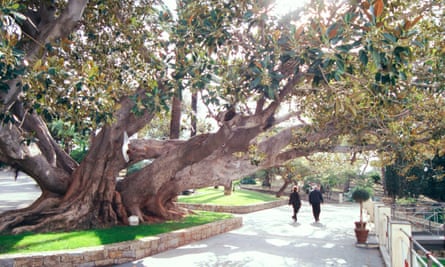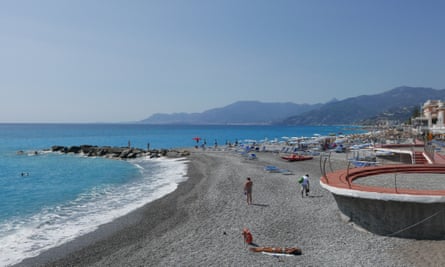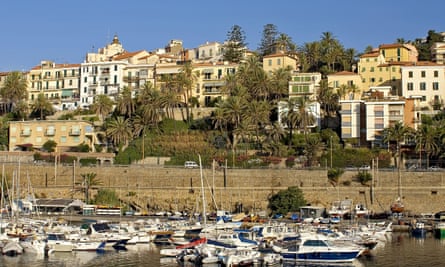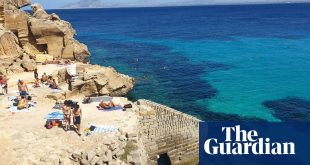Leaving my wife and daughter under a parasol on Bordighera’s beach, my teenage son and I set off in search of the largest Ficus macrophylla in western Europe.
The tree, commonly known as the strangler fig, was planted in 1886 by Clarence Bicknell, British botanist, collector, lover of Esperanto and chaplain of Bordighera’s Anglican church.
Bicknell loved the hilly, pine-covered coast between Sanremo and the French Riviera, but ended up loathing his “tea-party, gossipy” British congregation, who had “no international spirit”. He abandoned the church and spent his time painting flowers, cataloguing archaeological artefacts and taking rubbings of the prehistoric rock carvings in the maritime Alps.

Everything he did is now in the town’s Museo Bicknell, including his vast collection of butterflies, his sketch books, thousands of pressed flowers, a microscope and sepiolite clay pipe. The museum also gives visitors a glimpse of Bordighera in the 1880s, which at the time had a British population of more than 3,000, far outnumbering local people. They founded Italy’s first lawn tennis club in the resort and created exotic gardens around their extravagant villas. The museum’s facade is covered in a clenching, twisting wisteria which overwhelms the building with drooping, purple flowers in spring … There, crushing its entrance gate, is the 21-metre-high strangler fig, with aerial roots twisting down from its branches and a dainty palm tree growing up from between its buttress roots. There’s another monstrous-looking ficus in the garden beyond, where pines, oleander, lemons and aloe burst through the surrounding fences.
We walk along via Romana, past the art nouveau villa Regina Margherita (the same queen the pizza is named after) towards the medieval old town, in search of a some water fountains and ravioli.

High above the coast, the pentagon-shaped old town, the città alta, is a tangle of caruggi (narrow streets), decorated with pot plants and old bicycles dressed in flowers. There’s no need for a map: all roads lead into the same shady squares behind blanched walls with a few restaurant tables in the shade. Osteria Magiargè serves amazing ravioli stuffed with ossobuco with saffron cream, or a herby version with butter and thyme. A few alleys away, La Cicala does green ravioli filled with aubergine in a cherry tomato sauce and, the local speciality, fried courgette flowers with burrata.
Arcades and narrow passageways keep the old town cool but there is no shade on Bordighera’s seafront promenade. Halfway along is a rust-coloured bandstand dedicated to Evita Perón, who inaugurated the walkway – the Lungomare Argentina – during her visit in 1947. Either side are ice-cream parlours, bike-hire agencies (it’s a flat ride to Sanremo, eight miles away) and restaurants built on stilts over the beach.

Ravioli and brandacujun (creamed cod with olives and potatoes) aside, Bordighera is known for its pastries, so we pick up a slice of chocolate and pear tart and another of apple and maraschino from U Pesigu on via Vittorio Emanuele, plus an ice-cream in the shape of a hedgehog from a gelateria a few doors down and walk down on to the smooth pebbles. The beach is still in summer mode, with parasols up and loungers out but hardly anyone on them.
after newsletter promotion
My wife and daughter are watching over some bikes while their owners are in the sea. Tiziana and Tommaso have been cycling the Riviera dei Fiori from Genoa to Ventimiglia. “We’ve seen so many lovely places – Cervo, San Lorenzo al Mare and then we saw some whales …” says Tiziana. “But we love Bordighera because of the long promenade, the beach is so calm and you can eat overlooking the sea.” Tommaso wants to come back on Thursday for the clothes market. They were in Dolceacqua this morning, high up in a valley that inspired Claude Monet, and tomorrow they leave for Menton, a favourite with Queen Victoria.
The British fled Bordighera at the outbreak of the second world war leaving a town bursting with citrus trees, exotic plants and botanical gardens. Cactus enthusiasts can head to the steep-sided Pallanca Exotic Garden on the coast road to Sanremo, which has more than 3,000 varieties of cactus and succulents.

On the eastern seafront, just beyond a small marina, is the Villa Garnier, designed by French architect Charles Garnier in 1873. His terraced garden is open for visits and has a dragon tree, rows of date palms and bird-of-paradise flowers and a single column from the Tuileries in Paris.
In the late afternoon, we walk back up through the old town to the Beodo palm grove via a mule track and tunnel and see the view Monet painted when he visited in 1884. The trees are taller, but otherwise it looks just the same.
Villa Garnier (doubles from €94) has guest rooms and apartments in the gardens. Bordighera is seven minutes by train from Ventimiglia: the station is just behind the beach on the Lungomare Argentina
 Top Naija News: Nigerian News, Breaking News Nigeria and World News Top Naija News is a daily news publication in Nigeria, delivering the latest breaking news in Nigeria and around the world.
Top Naija News: Nigerian News, Breaking News Nigeria and World News Top Naija News is a daily news publication in Nigeria, delivering the latest breaking news in Nigeria and around the world.



